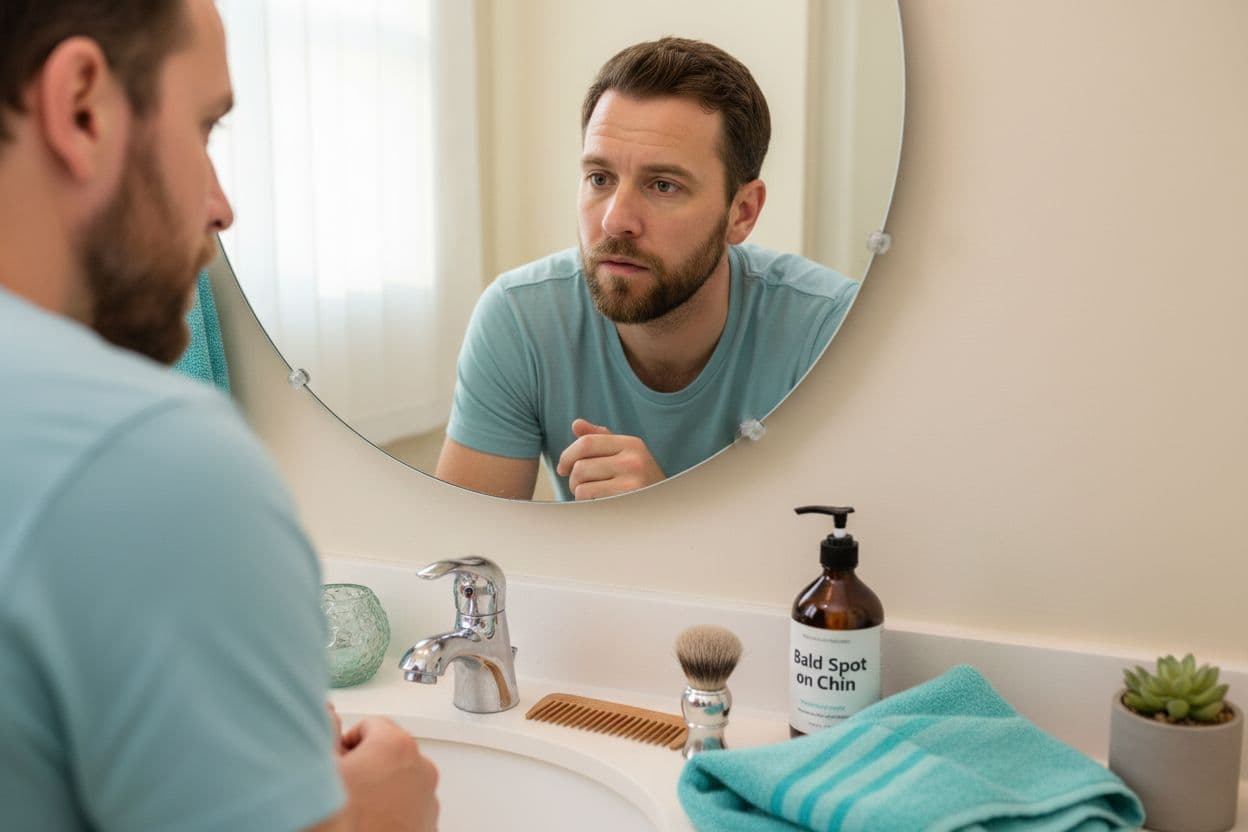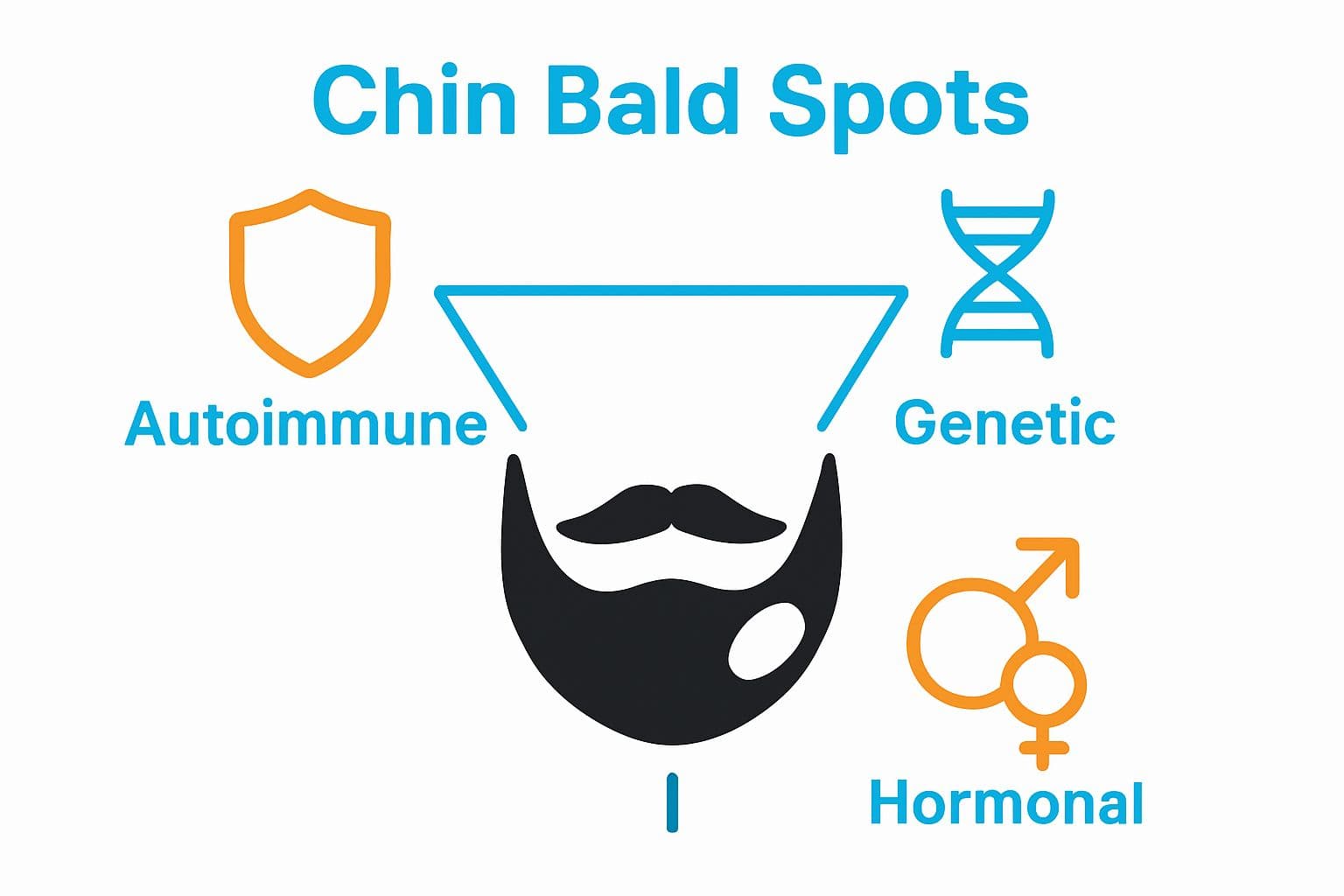Blog
Learning Materials
Understanding the Bald Spot on Chin: Causes and Insights
Updated: October 12, 2025

Noticing a bald spot on your chin can feel startling, especially when your beard seemed perfectly healthy just yesterday. Studies show that alopecia areata causes sudden patchy beard loss in up to 2 percent of the population, making chin bald spots much more common than people think. Oddly enough, the first visible patch is often a signal from your body about deeper immune or hormonal activity you rarely see.
Table of Contents
- What Is A Bald Spot On Chin? Understanding The Condition
- Why Does A Bald Spot On Chin Occur? Common Causes Explained
- How Does Hair Growth Work? The Biology Of Hair Follicles
- Impact Of A Bald Spot On Chin: Psychological And Social Aspects
- Finding Solutions: Treatments And Lifestyle Changes For Chin Bald Spots
Quick Summary
| Takeaway | Explanation |
|---|---|
| Bald spots indicate health issues. | Chin bald spots may signal underlying autoimmune or hormonal problems that require medical attention. |
| Recognize key bald spot traits. | Identifying smooth, circular patches on the chin aids early recognition and potential treatment. |
| Autoimmune responses are primary causes. | Conditions like alopecia areata lead to hair loss due to the immune system attacking hair follicles. |
| Stress and nutrition impact hair growth. | Lifestyle factors such as poor diet and stress can disrupt hair growth patterns and exacerbate bald spots. |
| Multifaceted treatment approaches are effective. | Combining medical interventions with lifestyle changes enhances recovery and promotes hair regrowth. |
What is a Bald Spot on Chin? Understanding the Condition
A bald spot on the chin represents an unexpected and localized area of hair loss specifically within the beard region, characterized by smooth, exposed skin where hair growth has suddenly ceased or become disrupted. This specific type of hair loss can emerge suddenly and create noticeable patches that deviate from normal hair distribution patterns.
The Underlying Mechanics of Chin Hair Loss
Chin bald spots typically originate from complex interactions between genetic predispositions, autoimmune responses, and physiological factors. Dermatological research from the National Institutes of Health indicates that these spots frequently result from alopecia areata, an autoimmune condition where the body's immune system mistakenly attacks hair follicles, causing sudden and often unpredictable hair loss.
The mechanisms behind chin bald spots can be multifaceted:
- Autoimmune Triggers: The immune system incorrectly identifies hair follicles as foreign entities
- Hormonal Fluctuations: Testosterone and other hormonal changes can impact hair growth patterns
- Genetic Predispositions: Family history plays a significant role in susceptibility
Recognizing and Understanding Chin Bald Spots
Recognizing a bald spot on the chin involves identifying specific characteristics such as:
- Perfectly circular or oval smooth patches
- Abrupt hair loss without gradual thinning
- Potential inflammation or redness around the affected area
- No scarring or permanent damage to the underlying skin
While these spots can be concerning, they are often treatable. For more comprehensive insights into hair growth patterns, read our guide on personalized hair analysis.
Understanding these bald spots requires acknowledging their complex nature: they are not simply cosmetic concerns but potential indicators of broader health dynamics involving immune function, hormonal balance, and genetic inheritance.
Why Does a Bald Spot on Chin Occur? Common Causes Explained
Bald spots on the chin emerge from a complex interplay of biological, genetic, and environmental factors that disrupt normal hair follicle functioning. These localized areas of hair loss represent more than cosmetic concerns, signaling potential underlying health conditions or physiological changes.
Autoimmune and Genetic Triggers
Clinical research from the American Academy of Dermatology reveals that autoimmune responses are primary drivers of chin bald spots. In these scenarios, the body's immune system mistakenly targets hair follicles, causing inflammation and interrupting normal hair growth processes. Genetic predispositions significantly contribute to this phenomenon, with certain individuals inheriting a higher susceptibility to autoimmune hair loss conditions.
Key genetic and autoimmune factors include:
- Inherited immune system variations
- Family history of alopecia or autoimmune disorders
- Specific genetic markers linked to hair loss
Hormonal and Physiological Influences
Hormonal fluctuations play a critical role in chin hair loss. Testosterone and related androgens can dramatically impact hair follicle behavior, potentially triggering localized hair loss. Explore our comprehensive guide on beard hair loss patterns to understand these complex interactions.
Additional physiological contributors include:
- Thyroid dysfunction
- Stress-induced hormonal changes
- Nutritional deficiencies
- Sudden metabolic shifts
Environmental and Lifestyle Factors
External elements can also precipitate chin bald spots. Chronic stress, poor nutrition, environmental toxins, and certain medications can disrupt hair growth cycles. Recognizing these factors allows for targeted interventions and potential prevention strategies.
Understanding chin bald spots requires a holistic approach, acknowledging the intricate connections between genetic predispositions, physiological health, and environmental influences.
Here is a table comparing the primary causes of chin bald spots, including their definitions and notable characteristics for quick reference.
| Cause Category | Definition | Notable Characteristics |
|---|---|---|
| Autoimmune Triggers | Immune system mistakenly attacks hair follicles (e.g., alopecia areata) | Sudden hair loss, smooth patches, possible inflammation |
| Genetic Predispositions | Inherited susceptibility to hair loss or autoimmune disorders | Family history, specific genetic markers |
| Hormonal Influences | Changes in hormones, particularly androgens and thyroid hormones | Fluctuating beard growth, possible links to health conditions |
| Physiological Factors | Changes in general body function (e.g., thyroid, metabolism) | Sudden onset with possible nutritional or metabolic contributors |
| Environmental Factors | Impact of surroundings, toxins, medications, or overall lifestyle choices | Occurs with stress, poor nutrition, medication, or toxin exposure |

How Does Hair Growth Work? The Biology of Hair Follicles
Hair growth represents a sophisticated biological process involving intricate cellular interactions and cyclical mechanisms that determine hair production, structure, and health. Understanding these complex processes provides crucial insights into why hair loss occurs and how hair follicles function.
The Hair Growth Cycle: A Precision Mechanism
Scientific research from the National Institutes of Health reveals that hair growth operates through three distinct phases: anagen (active growth), catagen (transition), and telogen (resting). Each hair follicle functions as a mini biological factory, independently cycling through these stages with remarkable precision.
Key characteristics of the hair growth cycle include:
- Dynamic cellular regeneration
- Independent follicular mechanisms
- Periodic shifts between growth and rest states
- Continuous regenerative potential
Cellular Foundations of Hair Production
Hair follicles are sophisticated mini organs composed of multiple cell types working in synchronization. Stem cells located in the follicle's bulb region play a critical role, continuously generating new hair cells and triggering growth signals. Hormonal influences, genetic programming, and environmental factors significantly modulate these cellular interactions.
Primary cellular components responsible for hair growth include:
- Keratinocyte cells producing hair protein
- Melanocytes determining hair pigmentation
- Dermal papilla cells regulating follicular activity
- Stem cells driving regenerative processes
Factors Influencing Hair Follicle Functionality
Multiple internal and external factors can disrupt normal hair growth patterns. For comprehensive strategies on maintaining healthy hair, explore our guide on hair growth techniques.
External and internal influences affecting hair follicle performance encompass:
- Nutritional status
- Hormonal balance
- Genetic predispositions
- Stress levels
- Metabolic health
Understanding hair growth transcends mere cosmetic interest. It represents a window into complex biological processes that reflect overall physiological well being.
The following table summarizes the main phases of the hair growth cycle, including their duration and core activities, to provide an easy reference for understanding follicular biology.
| Hair Growth Phase | Typical Duration | Core Activities |
|---|---|---|
| Anagen | 2-7 years | Active hair growth, rapid cell division, lengthening |
| Catagen | 2-3 weeks | Transition phase, follicle shrinks, growth stops |
| Telogen | 2-3 months | Resting, hair sheds, follicle prepares for new cycle |
Impact of a Bald Spot on Chin: Psychological and Social Aspects
A bald spot on the chin extends far beyond a mere physical condition, representing a profound intersection of emotional well being, social perception, and personal identity. These localized areas of hair loss can trigger complex psychological responses that significantly impact an individual's self image and social interactions.
Emotional and Psychological Dimensions
Clinical research from psychological health journals reveals that facial hair loss can substantially influence emotional stability and mental health. Beard bald spots often challenge fundamental perceptions of masculinity, creating potential emotional distress and decreased self confidence.
Key psychological impacts include:
- Heightened self consciousness
- Potential social anxiety
- Reduced perceived attractiveness
- Increased vulnerability to mood fluctuations
Social Perception and Identity Challenges
Facial hair plays a significant cultural role in defining personal identity and social presentation. A chin bald spot can disrupt an individual's established social narrative, potentially affecting professional interactions, romantic relationships, and personal self perception. Explore our comprehensive treatment strategies for managing hair loss to understand potential intervention approaches.
Social dynamics potentially influenced by chin bald spots encompass:
- Professional image perception
- Dating and romantic relationship dynamics
- Cultural and gender identity expressions
- Interpersonal communication confidence
Coping and Psychological Resilience
Navigating the emotional landscape of chin bald spots requires a multifaceted approach combining medical understanding, psychological support, and personal acceptance. Developing robust coping mechanisms involves recognizing that physical variations do not diminish personal worth or inherent value.
Strategies for psychological adaptation include:
- Seeking professional counseling
- Building supportive social networks
- Practicing self compassion
- Exploring medical treatment options
Ultimately, understanding and managing the psychological impact of chin bald spots transcends physical appearance, representing a journey of self acceptance and emotional growth.

Finding Solutions: Treatments and Lifestyle Changes for Chin Bald Spots
Addressing chin bald spots requires a comprehensive approach that combines medical interventions, lifestyle modifications, and holistic health strategies. Understanding the nuanced treatment landscape empowers individuals to develop personalized management plans tailored to their specific hair loss patterns.
Medical Treatment Approaches
Clinical research from dermatological experts highlights several targeted medical interventions for managing chin bald spots. Topical and systemic treatments can potentially stimulate hair regrowth and halt further follicular deterioration.
Primary medical treatment strategies include:
- Corticosteroid injections
- Topical immunotherapy
- Platelet rich plasma therapy
- Prescription medications like minoxidil
- Immunosuppressant treatments
Lifestyle and Nutritional Interventions
Holistic management extends beyond medical treatments, incorporating targeted lifestyle modifications that support overall hair health. Discover comprehensive hair restoration techniques to complement medical interventions.
Key lifestyle factors influencing chin bald spot recovery:
- Stress reduction techniques
- Balanced nutritional intake
- Regular sleep patterns
- Hormonal balance management
- Minimizing physical skin trauma
Complementary and Supportive Strategies
Comprehensive chin bald spot management involves integrating multiple approaches. Psychological support, dietary adjustments, and gentle skincare practices can significantly enhance medical treatment effectiveness.
Supplementary strategies to support recovery include:
- Regular dermatological consultations
- Gentle beard and skin care routines
- Nutritional supplementation
- Stress management practices
- Exploring alternative therapeutic approaches
Successful management of chin bald spots requires patience, consistent approach, and a holistic understanding of individual physiological dynamics.
Take Control of Your Chin Bald Spot With Personalized Insights
Struggling with a smooth, unexpected patch of hair loss on your chin can feel isolating and frustrating. The unpredictability of beard bald spots and the complex mix of triggers like autoimmune responses or hormonal changes can bring anxiety and even impact your confidence. But you do not need to face this challenge alone. Understanding how your unique hair follicles behave is the crucial first step toward seeing real improvement. Our advanced AI-powered analysis at MyHair.ai unlocks what is behind your specific hair loss and gives you actionable guidance in minutes.

Ready for answers backed by science and technology? Upload your scan on MyHair.ai to receive a detailed report with personalized strategies for stimulating chin hair regrowth. Discover which products and routines really fit your situation by exploring our hair bald spot treatment solutions and hair growth techniques. Start your journey toward a fuller beard and renewed confidence today—do not wait to take action when relief and results are within reach.
Frequently Asked Questions
What causes a bald spot on the chin?
A bald spot on the chin primarily results from autoimmune conditions such as alopecia areata, where the immune system mistakenly attacks hair follicles. To better understand your specific situation, consider consulting a dermatologist who can evaluate potential underlying causes related to your health.
How can I identify a bald spot on my chin?
You can recognize a bald spot on your chin by looking for smooth, circular patches of skin with no hair. If you notice abrupt hair loss without gradual thinning and some inflammation, it’s important to seek medical advice to determine the cause and next steps.
What are effective treatments for a bald spot on the chin?
Effective treatments include corticosteroid injections, topical immunotherapy, and prescription medications. To find the right course of action, schedule an appointment with a healthcare professional to discuss the best treatment options based on your specific hair loss.
Can lifestyle changes help with chin bald spots?
Yes, stress reduction, balanced nutrition, and proper sleep can significantly support hair health and recovery from bald spots. Aim to incorporate stress management techniques and a balanced diet rich in vitamins and minerals to enhance your overall well-being.
How do hormonal changes influence bald spots on the chin?
Hormonal fluctuations, particularly with testosterone, can impact hair growth and contribute to bald spots. If you suspect hormonal issues, track changes in your health and discuss them with a healthcare provider for tailored guidance.
What psychological effects can a bald spot on the chin have?
A bald spot on the chin can lead to emotional distress, reduced self-confidence, and social anxiety regarding personal appearance. Address these effects by seeking support from mental health professionals or supportive social networks to help manage feelings related to hair loss.